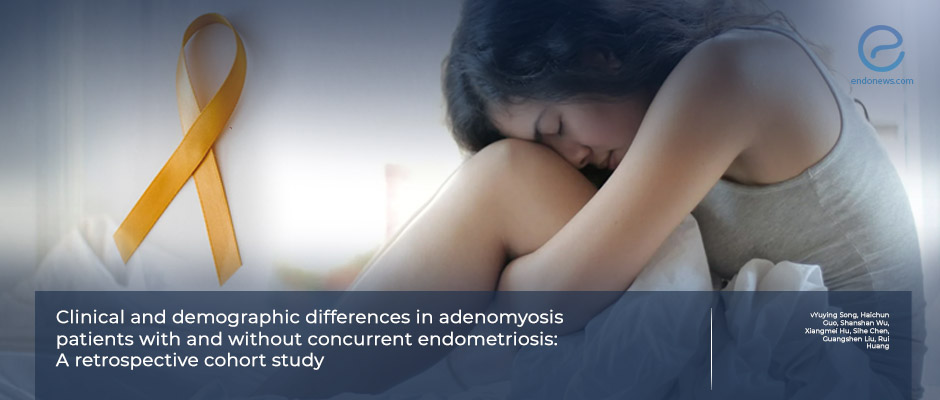Predictors and Symptom Burden in Adenomyosis-Endometriosis Overlap
Jul 25, 2025
Women with both adenomyosis and endometriosis face greater pain burden, reproductive symptoms, and earlier menarche onset
Key Points
Highlights:
- Understanding how concurrent endometriosis alters the clinical presentation of adenomyosis is essential for tailored diagnostics and treatment.
- Women with both conditions present with more severe gynecological symptoms and reproductive challenges.
- This study identifies key clinical predictors that can aid in earlier detection of dual pathology.
Importance:
- Adenomyosis with concurrent endometriosis is not merely additive—it represents a distinct and more burdensome clinical entity.
- Early screening and personalized management strategies for this subgroup could improve reproductive and quality-of-life outcomes.
What’s done here?
- A 6-year retrospective cohort study (2015–2020) analyzed the medical records of 307 women diagnosed with adenomyosis at a tertiary center in Changsha, China.
- Patients were categorized into two groups: those with adenomyosis alone (n=160) and those with concurrent endometriosis (n=147).
- Data collected included demographics, symptom profiles, and diagnostic imaging results.
- Statistical analyses (t-tests, chi-square, logistic regression) were used to assess group differences and predictors of dual diagnosis.
Key results:
- Mean age was significantly higher in the concurrent group (48.9 vs. 39.2 years; P = 0.001).
- Early menarche (<13 years) was more common among women with both conditions (62.6% vs. 34.4%; P < 0.001).
- Menorrhagia and dysmenorrhea were significantly more prevalent in the concurrent group (72.1% vs. 26.3%, and 67.3% vs. 28.1%, respectively; P < 0.001).
- Dyspareunia (59.2% vs. 46.3%; P = 0.023) and spontaneous abortion (69.2% vs. 52.3%; P = 0.007) rates were also higher in those with dual pathology.
- Multivariable regression identified older age and early menarche as independent predictors of concurrent endometriosis in adenomyosis patients.
Limitations
- The retrospective, single-center design limits causal inference and generalizability.
- Reliance on imaging-based diagnosis without histopathologic confirmation may reduce diagnostic accuracy.
- Potential confounding from unmeasured variables (e.g., severity, hormonal treatment history) was not addressed.
From the Editor-in-Chief – EndoNews
"This study reframes adenomyosis as more than a standalone condition—when endometriosis coexists, the clinical picture shifts dramatically. These women are older, present with earlier menarche, and endure more severe symptoms, including heavier bleeding, greater pain, and increased reproductive loss. The identification of these predictors demands a change in how we approach diagnosis. Early menarche and age are not trivial history points—they are red flags for dual disease.
Clinicians must move beyond treating symptoms in isolation. Overlooking concurrent endometriosis means misdiagnosis, mistreatment, and missed opportunities for fertility preservation. Precision in care starts with precision in suspicion—and this study makes the case unambiguously."
Lay Summary
Adenomyosis and endometriosis are two gynecological conditions that often overlap but are frequently misunderstood.
Adenomyosis occurs when endometrial tissue grows into the muscular wall of the uterus, while endometriosis involves similar tissue growing outside the uterus.
Both can cause chronic pelvic pain, heavy menstrual bleeding, and infertility—but when they occur together, symptoms may be more severe and harder to manage.
In a recent study published in the Journal of Gynecology Obstetrics and Human Reproduction, researchers from Changsha, China, examined over 300 medical records of women diagnosed with adenomyosis.
They compared women with adenomyosis alone to those who also had coexisting endometriosis.
The findings revealed that women with both conditions were typically older, had experienced earlier onset of menstruation (menarche), and reported more intense symptoms—particularly heavy menstrual bleeding, painful periods, painful intercourse, and higher rates of miscarriage.
Importantly, early menarche and older age were found to be strong predictors of concurrent endometriosis in women with adenomyosis.
These insights emphasize the need for clinicians to consider early screening and individualized treatment plans when these risk factors or severe symptoms are present, ultimately aiming to improve diagnosis, symptom control, and fertility outcomes.
Research Source: https://pubmed.ncbi.nlm.nih.gov/40513987/
adenomyosis endometriosis menorrhagia dysmenorrhea dyspareunia infertility

